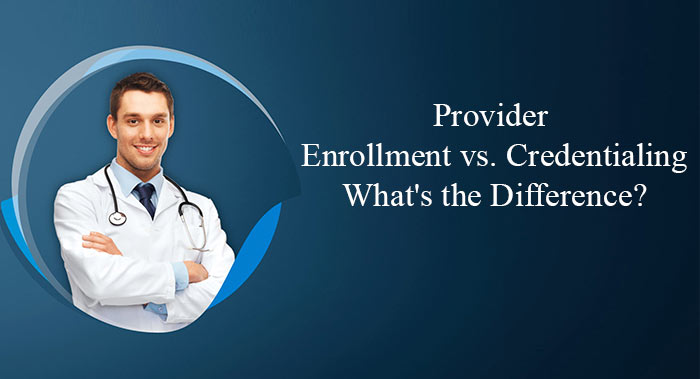
Provider Enrollment vs Credentialing What is the Difference
If you are confused between provider enrollment and credentialing, you have landed on the right platform. However, both are vital processes in the healthcare industry and are crucial for building a successful provider enrollment program. This piece of work will help you navigate the key difference between provider enrollment and credentialing. Let’s begin!
What is Provider Enrollment?
In the USA, a provider must enroll in an effective health plan before providing medical services to the patients. Many insurance companies host a range of health insurance plans that a patient usually has to look at before getting medical services. Hence, the provider needs to be enrolled in one or many health insurance plans that enable them to receive reimbursements for the medical services they perform.
To finalize the provider enrollment procedure, it's essential to begin with the provider credentialing process. Payers mandate the completion of the credentialing process to gather all necessary information before allowing the enrollment of a new provider. So, let’s get to what provider credentialing is.
What is Provider Credentialing?
Provider credentialing involves the verification of a new provider's qualifications before they join a healthcare practice. It’s the first step of the application that involves time-consuming and tedious tasks. Although the healthcare practice usually conducts this process, insurance payers demand the same credentialing data as part of the provider enrollment procedure. In this process, the insurance company notes down all the details of the training professional, and it goes through a primary verification process.
The verification of training is of utmost importance because health plans mandate that providers meet specific training and educational prerequisites to be listed under their requested specialty. The provider's record undergoes a meticulous examination, identifying issues requiring reporting to the credentialing committee for a final decision on network admission. After a comprehensive review, the file is queued for the next committee meeting for approval. Upon approval, a "welcome letter" is dispatched, informing the provider of the effective date, the essential provider number for billing, and other pertinent details needed for accessing web portals, checking claims status, and other essential resources for a network provider.
Steps for Building a Successful Provider Enrollment Program and Credentialing
Building a successful provider enrollment program and credentialing process is crucial for healthcare organizations to ensure the quality and compliance of their network. These programs are essential for managing the entry of new healthcare providers and maintaining their credibility within the system.
Here are the key steps for establishing and maintaining a successful provider enrollment program and credentialing process:
- Establish Clear Policies and Procedures
The foundation of a successful program begins with well-defined policies and procedures. Develop a comprehensive manual that outlines the entire enrollment and credentialing process, including the criteria for providers to meet, documentation required, and deadlines.
- Compliance with Regulatory Requirements
Stay informed and comply with the ever-evolving healthcare regulations. This includes federal and state laws, as well as payer-specific requirements. Adherence to these regulations is critical to avoid potential legal issues.
- Application Submission
Ensure a streamlined and user-friendly application process. Make it easy for providers to submit their applications, and consider online submission options to expedite the process.
- Verification of Credentials
The heart of the credentialing process is the verification of a provider's qualifications, education, training, and work history. This includes checking licenses, certifications, malpractice history, and any disciplinary actions.
- Peer Review and Committee Evaluation
Many organizations have peer review committees that assess a provider's clinical competence and ethical conduct. These evaluations help maintain high standards of patient care.
- Database Management
Implement a robust credentialing database system to keep track of provider information and documentation. This system should be secure, organized, and easily accessible for authorized personnel.
- Monitoring and Re-credentialing
Provider credentialing is an ongoing process. Regularly review and update provider information and establish a schedule for re-credentialing to ensure that providers continue to meet the required standards.
- Communication with Payers
Effective communication with payers is vital. Be aware of each payer's specific requirements and maintain open lines of communication to expedite the enrollment process.
- Provider Orientation
Once a provider is successfully enrolled, provide orientation to help them understand your organization's policies, procedures, and expectations.
- Continuous Quality Improvement
Regularly evaluate your provider enrollment and credentialing process. Seek feedback from your team and providers to identify areas for improvement and refine your procedures accordingly.
- Documentation and Reporting
Accurate record-keeping and reporting are crucial for audits and compliance. Maintain comprehensive records of the credentialing and enrollment process.
- Training and Education
Invest in training and education for your staff involved in the enrollment and credentialing process to keep them updated on industry best practices and regulatory changes.
Provider enrollment and credentialing are pivotal processes in the healthcare industry, each serving a unique but interconnected purpose. By carefully adhering to these steps, healthcare organizations can not only streamline the onboarding of new providers but also maintain the integrity of their networks, complying with ever-changing regulations and offering the highest standards of care. This also helps in building a successful provider enrollment program. The success of these processes not only benefits healthcare organizations but, more importantly, ensures the well-being of patients who rely on these networks for their healthcare needs.





